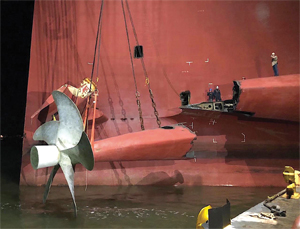The vehicle carrier Golden Ray, which capsized in September after leaving Georgia’s Port of Brunswick, remained submerged on its side in mid-February as salvors finalized plans to break it up for removal. The ship was loaded with about 4,200 vehicles when it rolled over.
A unified command (UC) consisting of members of the U.S. Coast Guard, the Georgia Department of Natural Resources, and Gallagher Marine Systems — the company representing vessel owner Hyundai Glovis — opted to cut up the ship after determining that it could not be safely refloated. Plans are in place to erect an environmental protection barrier (EPB) and complete salvage operations before the start of the hurricane season in June.
T&T Salvage has been contracted by Hyundai Glovis to construct the EPB and remove the wreck from St. Simons Sound. The work will be over-seen by the unified command. Donjon-SMIT was the initial response contractor.
The Marshall Islands-flagged Golden Ray departed Brunswick on Sept. 8 after discharging and loading vehicles. The ship prepared to make a starboard turn around Jekyll Island when a stability issue developed, causing the vessel to list to port and roll over. All 24 mariners aboard were rescued, including four who were trapped belowdecks for a day and a half. The Coast Guard and National Transportation Safety Board are investigating the cause of the accident.
The U.S. Army Corps of Engineers issued permits on Feb. 4 to build the EPB, which will include floating boom to contain surface pollutants and a double layer of netting for subsurface debris. The operation will require pile driving during daylight hours, according to the unified command, which warned the public to expect “construction noise.”
“We are doing everything we can to get this wreck removal right,” said Kevin Perry of Gallagher Marine Systems. “This includes considering every last detail of the EPB, including how its construction will impact marine life and what level of noise the citizens of St. Simons Island can expect while it is being built.”
After the barrier is built, salvage crews will begin splitting up the hull. A large diamond-cutting chain will be deployed from a floating crane to make seven cuts, each taking approximately 24 hours of continuous operation. This will divide the wreck into eight sections weighing between 2,700 and 4,100 tons apiece. The sections will be loaded onto a barge and taken to a recycling facility.
Once the debris removal operation is complete, a hydrographic survey will be conducted to ensure the seabed is free of debris from the wreck. Once free of debris, the barrier will be removed.
“The goal is for all large sections of the vessel to be removed before hurricane season in June, with subsequent recovery of debris and any remaining portions of the wreck following large section removal,” said Kimberly Garvey, chief of planning for the Army Corps’ Savannah District. “The final removal and site clearance would be completed after this date.”
John Maddox, on-scene coordinator for the Georgia Department of Natural Resources, said the unified command considered input from “multiple experts and stakeholders” when moving forward with plans for the EPB and wreck removal.
“This is a complicated project with lots of moving parts,” Maddox said. “The UC is pleased that this phase of the planning process is almost complete and appreciates the patience of local residents and visitors of St. Simons as we get closer to removing Golden Ray.”

